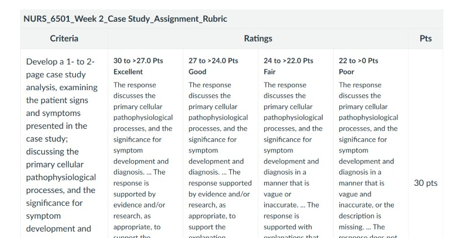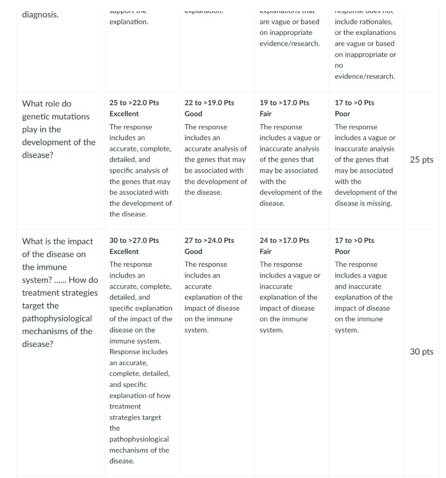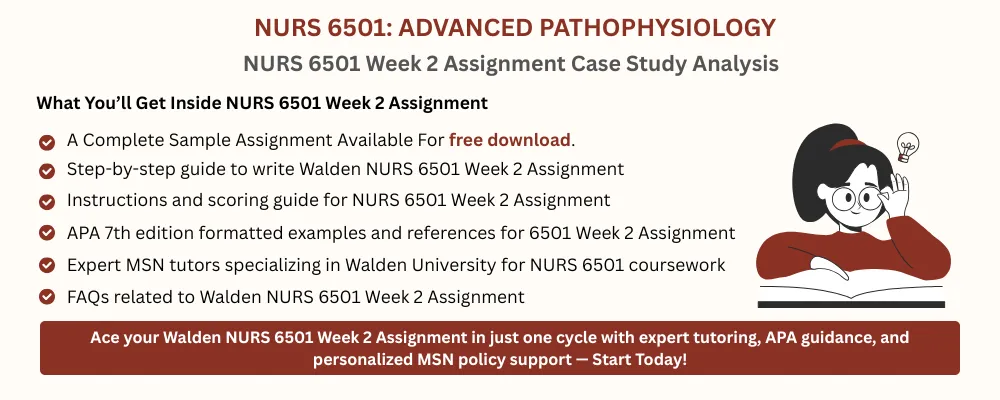NURS 6501 Week 2 Assignment FREE DOWNLOAD
NURS 6501 Week 2 Assignment
Case Study Analysis
Student Name
Walden University
NURS6501
Professor Name
Date
Case Study Analysis
The neurodegenerative disease Amyotrophic Lateral Sclerosis (ALS) damages motor neurons until it causes complete muscle weakness, together with respiratory difficulties and entire body paralysis. A research study investigates familial ALS development through genetics while evaluating the disease’s impact on immune systems and discusses available treatment methods for the condition (Verma et al., 2022). This analysis has two main goals. These are to determine the mechanisms that cause this condition and to investigate new treatment methods. The 32-year-old patient Maria Lopez shows symptoms of familial ALS with SOD1 gene mutation by developing advanced muscle weakness, swallowing problems, and repeated respiratory infections.
Pathophysiological Process & Symptom Development
The disorder called ALS causes a molecular breakdown of both upper and lower motor neurons, which produces ongoing muscle tissue deterioration and someones ‘ ability to perform voluntary body movements. The deterioration of motor neurons causes an irreversible decline of signal transmission to muscles that leads to muscle weakness with spasticity and complete muscle loss (Mitchell et al., 2024). Neuronal death results from cellular dysfunction through oxidative stress, mitochondrial damage, and excitotoxicity. It produces muscle atrophy together with dysphagia and respiratory disability. Scientists have determined glutamate excitotoxicity and protein aggregation work as major factors in developing symptoms that produce permanent neurological damage.
Genetic Mutations and Disease Development
The SOD1 gene mutation that causes Familial ALS allows superoxide dismutase enzyme 1 to break free radicals into non-harmful entities. Some forms of SOD1 protein malfunction result in aggregation, which produces toxic chains that create oxidative stress that speeds up motor neuron degeneration (Naik et al., 2025). In numerous familial ALS cases, autosomal dominance rules how disease heredity works since one SOD1 mutation raises the risk of inheriting it. Ascertaining disease risk requires at-risk persons to undergo genetic testing accompanied by professional counseling.
Impact of ALS on the Immune System
The disease characteristic of ALS involves persistent neuroinflammation that leads to microglial activation and higher concentrations of inflammatory mediators. Processing of the disease advances when the immune system becomes uncontrolled because it worsens damage to neurons while making it harder for the body to eliminate harmful protein clusters. Patients with advanced ALS develop immune system deficiencies (Piancone et al., 2021). It significantly increases their risk of getting respiratory infections that become the primary causes of death in this condition. The successful treatment of inflammation and infection requires immediate focus for better patient responses.
Treatment Strategies and Pathophysiological Targeting
Medical care aims to decelerate ALS progression and handle symptoms since there is no known cure for the disease. The FDA approves Riluzole and Edaravone as the current medicines that delay survival decline (Pattee et al., 2023). The maintenance of quality of life depends heavily on supportive care measures. It includes physical therapy together with non-invasive ventilation, as well as nutritional support. Medical research teams evaluate three promising experimental approaches. These are stem cell therapy, gene silencing strategies, and neuroprotective medications to fight ALS disease-based mechanisms.
Conclusion
The described case presents an overview of ALS that reveals its multilayered nature and explains both its genetic composition and disease processes and treatment difficulties. The management of familial ALS requires immediate detection along with genetic support, which helps patients get necessary interventions promptly. Research involving gene therapy in combination with studies of neuroinflammation and regenerative medicine continue to develop new methods for better ALS treatment and potential therapeutic breakthroughs.
Instructions To Write NURS 6501 Week 2 Assignment
Need instructions for this assessment? Contact us now and get expert guidance right away!
Instructions File For 6501 Week 2 Assignment
CASE STUDY ANALYSIS
An understanding of cells and cell behavior is a critically important component of disease diagnosis and treatment. But some diseases can be complex in nature, with a variety of factors and circumstances impacting their emergence and severity.
Effective disease analysis often requires an understanding that goes beyond isolated cell behavior. Genes, the environments in which cell processes operate, the impact of patient characteristics, and racial and ethnic variables all can have an important impact.
An understanding of the signals and symptoms of alterations in cellular processes is a critical step in the diagnosis and treatment of many diseases. For APRNs, this understanding can also help educate patients and guide them through their treatment plans.
In this Assignment, you examine a case study and analyze the symptoms presented. In 1-2 pages, you will answer the questions provided following the case scenario. You must use current evidence-based resources to support your answers. Follow APA guidelines. Follow the grading rubric.
RESOURCES
Be sure to review the Learning Resources before completing this activity. Click the weekly resources link to access the resources.
WEEKLY RESOURCES
To prepare:
By Day 1 of this week, you will be assigned to a specific case study for this Case Study Assignment. Please see the “Announcements” section of the classroom for your assignment from your instructor.
The Assignment
Develop a 1- to 2-page case study analysis by answering the questions provided following the case scenario.
BY DAY 7 OF WEEK 2
Submit your Case Study Analysis Assignment by Day 7 of Week 2.
Reminder: The College of Nursing requires that all papers submitted include a title page, introduction, summary, and references. The sample paper provided at the Walden Writing Center provides an example of those required elements (available at https://academicguides.waldenu.edu/writingcenter/templates). All papers submitted must use this formatting.
SUBMISSION INFORMATION
Before submitting your final assignment, you can check your draft for authenticity. To check your draft, access the Turnitin Drafts from the Start Here area.
To submit your completed assignment, save your Assignment as WK2Assgn2_LastName_Firstinitial
Then, click on Start Assignment near the top of the page.
Next, click on Upload File and select Submit Assignment for review.
NURS 6501 Week 2 Assignment Rubrics



References For NURS 6501 Week 2 Assignment
Mitchell, A. K., Bliss, R. R., & Church, F. C. (2024). Exercise, neuroprotective exerkines, and parkinson’s disease: A narrative review. Biomolecules, 14(10), 1241–1241. https://doi.org/10.3390/biom14101241
Naik, R. A., Mir, M. N., Malik, I. A., Bhardwaj, R., Alshabrmi, F. M., Mahmoud, M. A., Alhomrani, M., Alamri, A. S., Alsanie, W. F., Hjazi, A., Ghatak, T., Poeggeler, B., Singh, M. P., TS, G., & Singh, S. K. (2025). The potential mechanism and the role of antioxidants in mitigating oxidative stress in alzheimer’s disease. Frontiers in Bioscience-Landmark, 30(2). https://doi.org/10.31083/fbl25551
Pattee, G. L., Genge, A., Couratier, P., Lunetta, C., Sobue, G., Akiyama, M., Yoshino, H., Jackson, C. E., Wymer, J. P., Salah, A., & Nelson, S. K. (2023). Oral edaravone – Introducing a flexible treatment option for amyotrophic lateral sclerosis. Expert Review of Neurotherapeutics, 23(10), 859–866. https://doi.org/10.1080/14737175.2023.2251687
Piancone, F., La Rosa, F., Marventano, I., Saresella, M., & Clerici, M. (2021). The role of the inflammasome in neurodegenerative diseases. Molecules (Basel, Switzerland), 26(4), 953. https://doi.org/10.3390/molecules26040953
Verma, S., Khurana, S., Vats, A., Sahu, B., Ganguly, N. K., Chakraborti, P., Gourie-Devi, M., & Taneja, V. (2022). Neuromuscular junction dysfunction in amyotrophic lateral sclerosis. Molecular Neurobiology, 59(3), 1502–1527. https://doi.org/10.1007/s12035-021-02658-6
Best Professors To Choose From For NURS 6512 Class
- Tara Harris
- Deborah Terry
- Stephen Crumb
- Adma Wilson-Romans
- Sharita Cole
(FAQs) related to NURS 6501 Week 2 Assignment
Question 1: Where can I download a free sample for NURS 6501 Week 2 Assignment?
Answer 1: Download a free sample from Tutors Academy.
Question 2: Where can I find the rubrics and instruction file for NURS 6501 Week 2 Assignment?
Answer 2: Get the rubric and instruction file from the Tutors Academy website.
Do you need a tutor to help with this paper for you with in 24 hours.
- 0% Plagiarised
- 0% AI
- Distinguish grades guarantee
- 24 hour delivery

